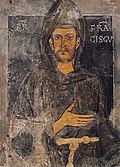Most High, all powerful, good Lord,
Yours are the praises, the glory, the honour, and all blessing.
To You alone, Most High, do they belong,
and no man is worthy to mention Your name.
Be praised, my Lord, through all your creatures,
especially Sir Brother Sun,
who brings the day; and you give light through him.
And he is beautiful and radiant in all his splendour!
Of you, Most High, he bears the likeness.
Praised be You, my Lord, through Sister Moon and the stars,
in heaven you formed them clear and precious and beautiful.
Praised be You, my Lord, through Brother Wind,
and through the air, cloudy and serene,
and every kind of weather through which you give sustenance to Your creatures.
Praised be You, my Lord, through Sister Water,
which is very useful and humble and precious and chaste.
Praised be You, my Lord, through Brother Fire,
through whom you light the night and he is beautiful
and playful and robust and strong.
Praised be You, my Lord, through Sister Mother Earth,
who sustains us and governs us and who produces
varied fruits with coloured flowers and herbs.
Praised be You, my Lord, through those who give pardon for Your love,
and bear infirmity and tribulation.
Blessed are those who endure in peace
for by You, Most High, they shall be crowned.
Praised be You, my Lord, through our Sister Bodily Death,
from whom no living man can escape.
Woe to those who die in mortal sin.
Blessed are those who will find Your most holy will,
for the second death shall do them no harm.
Praise and bless my Lord, and give Him thanks and serve Him with great humility. [4]

![Reproduction of the Codice 338, f.f. 33r - 34r, sec. XIII - Biblioteca del Sacro Convento [it] Cantico delle Creature.djvu](http://upload.wikimedia.org/wikipedia/commons/thumb/3/30/Cantico_delle_Creature.djvu/page1-250px-Cantico_delle_Creature.djvu.jpg)
